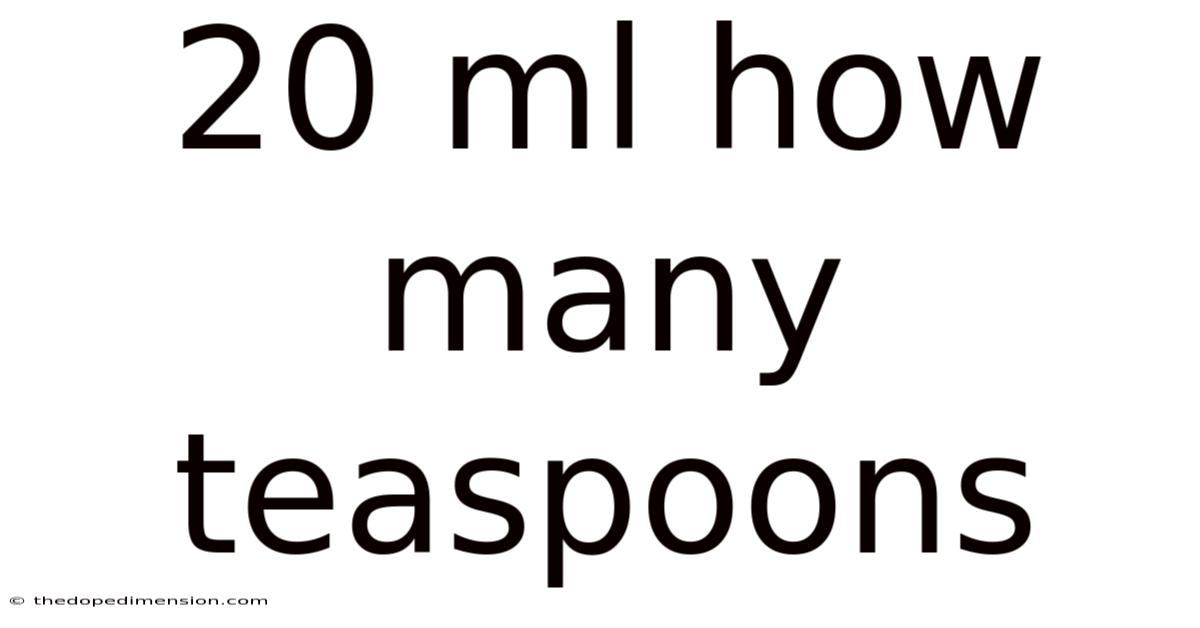20 Ml How Many Teaspoons
thedopedimension
Sep 23, 2025 · 4 min read

Table of Contents
20 ml: How Many Teaspoons? A Comprehensive Guide to Volume Conversions
Understanding volume conversions is crucial in various aspects of life, from cooking and baking to medicine and science. Frequently, we encounter situations where we need to convert milliliters (ml) to teaspoons (tsp), especially in recipes or when dealing with liquid measurements. This comprehensive guide delves into the conversion of 20 ml to teaspoons, providing a clear understanding of the process and exploring the nuances involved. We'll cover the basics, address common misconceptions, and provide extra tips for accurate conversions.
Introduction: Understanding Milliliters and Teaspoons
Before diving into the conversion, let's establish a clear understanding of the units involved. Milliliters (ml) are a unit of volume in the metric system, while teaspoons (tsp) are a unit of volume in the imperial system. The conversion factor between these two units is not a whole number, leading to some confusion. This article will clarify the conversion and explain why slight variations might exist depending on the source.
The Conversion: 20 ml to Teaspoons
The generally accepted conversion factor is that 1 milliliter is approximately equal to 0.202884 teaspoons. Therefore, to convert 20 ml to teaspoons, we perform the following calculation:
20 ml * 0.202884 tsp/ml ≈ 4.05768 tsp
Rounding to the nearest tenth, we get approximately 4.1 teaspoons. However, it's crucial to understand that this is an approximation. Different sources might use slightly varying conversion factors, resulting in minor differences in the final answer.
Factors Affecting Accuracy: Why the Slight Variations?
The slight variations you might encounter in conversion results stem from several factors:
-
Different Teaspoon Sizes: Teaspoons aren't standardized across the globe. Their size can slightly vary depending on the region and even the manufacturer of the measuring spoon. This variation directly impacts the accuracy of the conversion.
-
Rounding Errors: The conversion factor itself is an approximation. Rounding during calculations can accumulate minor errors, particularly when dealing with larger volumes.
-
Liquid Density: The density of the liquid being measured affects the volume. For example, a teaspoon of honey will weigh more than a teaspoon of water due to the higher density of honey. However, this factor is generally negligible for everyday conversions.
Practical Applications: When Precision Matters
The accuracy required for conversion depends heavily on the context. Here are some examples:
-
Cooking and Baking: For most recipes, the approximation of 4.1 teaspoons is sufficiently accurate. Slight variations in liquid volume rarely impact the final outcome of a dish significantly.
-
Medicine: In medical contexts, precision is paramount. Minor discrepancies in dosage can have significant health consequences. Always adhere to the instructions provided by a healthcare professional and use calibrated measuring tools for medications.
-
Scientific Experiments: Scientific experiments require high precision. The use of precise measuring instruments and careful calculations are essential for reliable and reproducible results.
Beyond the Basics: Mastering Volume Conversions
While this article focuses on converting 20 ml to teaspoons, understanding the underlying principles allows you to convert other volumes effectively. Here are some helpful tips:
-
Use a Reliable Conversion Calculator: Online conversion calculators can provide accurate results, eliminating the need for manual calculations. However, always check the source's reliability.
-
Understand the Conversion Factor: Knowing the conversion factor (approximately 0.202884 tsp/ml) empowers you to convert any milliliter volume to teaspoons.
-
Practice Makes Perfect: The more you practice conversions, the more comfortable you'll become with the process.
Frequently Asked Questions (FAQ)
-
Q: Can I use a tablespoon instead of a teaspoon? A: Yes, you can, but remember the conversion factor: 1 tablespoon (tbsp) is approximately equal to 3 teaspoons (tsp). Therefore, 4.1 teaspoons is approximately 1.4 tablespoons.
-
Q: What if I only have a measuring cup? A: Measuring cups are typically marked in milliliters or fluid ounces. You can use a measuring cup to measure 20 ml directly, avoiding the need for conversion.
-
Q: Why are there slight discrepancies between different conversion tools? A: As mentioned earlier, variations in teaspoon sizes and rounding errors contribute to slight discrepancies between different conversion tools.
-
Q: Is it okay to round the result up or down? A: For cooking and baking, rounding to the nearest tenth (4.1 tsp) is generally acceptable. For medical or scientific applications, adhere to the exact value or follow the specific instructions provided.
Conclusion: Accurate Conversions for Everyday Use
Converting 20 ml to teaspoons yields approximately 4.1 teaspoons. However, the exact value might vary slightly depending on the conversion factor used and the accuracy of the measuring tools employed. Understanding the factors influencing conversion accuracy, along with mastering the conversion process itself, empowers you to tackle similar volume conversion challenges with confidence. Remember to always consider the context and choose the appropriate level of precision for your needs. Whether you're baking a cake or conducting a scientific experiment, accurate measurements are key to success. So next time you need to convert milliliters to teaspoons, remember this comprehensive guide and measure with confidence!
Latest Posts
Latest Posts
-
Decimals Of A Foot Chart
Sep 23, 2025
-
The Basic Unit Of Volume
Sep 23, 2025
-
340 Miles To Km H
Sep 23, 2025
-
1 150 Gr To Mg
Sep 23, 2025
-
27000 Colombian Pesos To Dollars
Sep 23, 2025
Related Post
Thank you for visiting our website which covers about 20 Ml How Many Teaspoons . We hope the information provided has been useful to you. Feel free to contact us if you have any questions or need further assistance. See you next time and don't miss to bookmark.